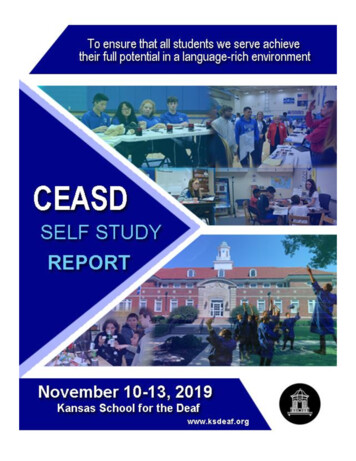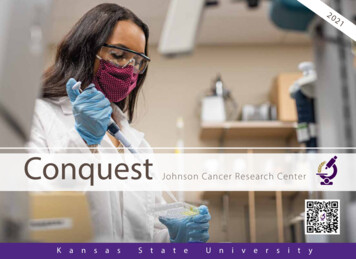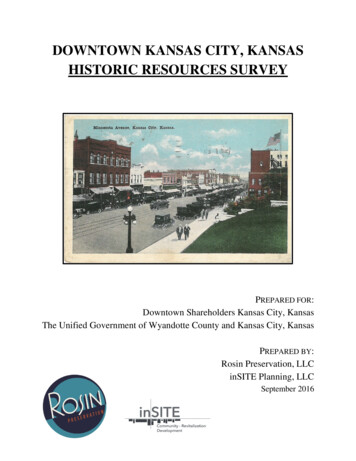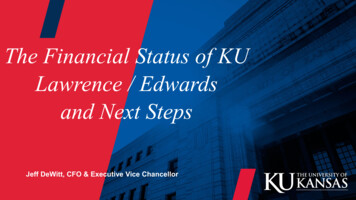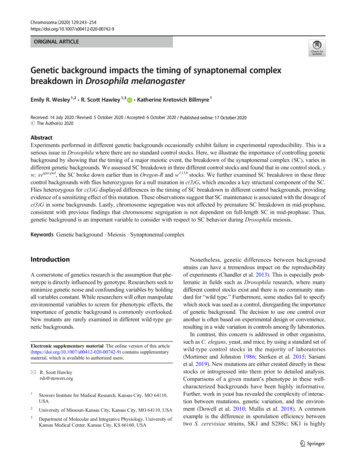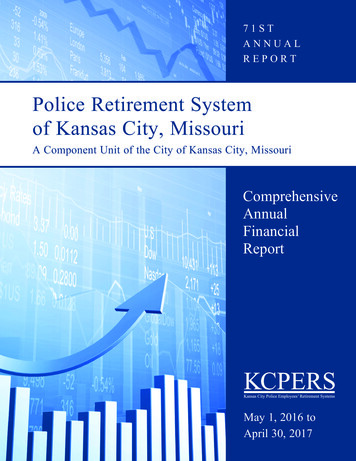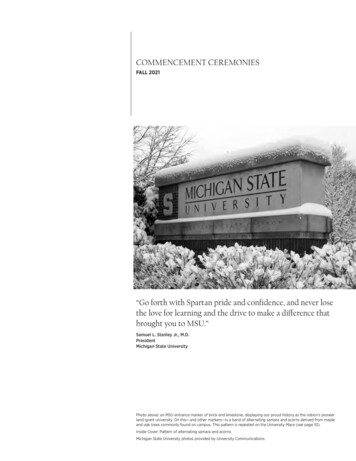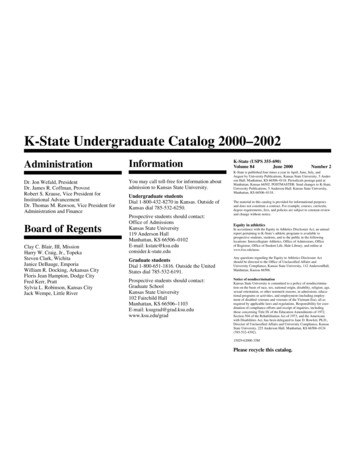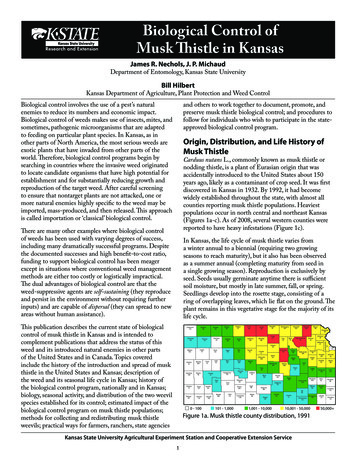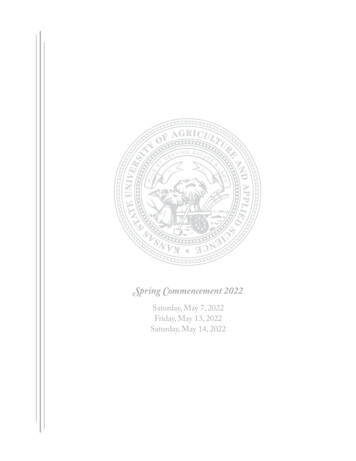
Transcription
Spring Commencement 2022Saturday, May 7, 2022Friday, May 13, 2022Saturday, May 14, 2022
Commencement ScheduleSaturday, May 7, 2022Saturday, May 14, 2022631Kansas State University SalinaStudent Life Center, 10 a.m.College of Arts and SciencesBramlage Coliseum, 8:30 a.m.Friday, May 13, 20229Graduate SchoolBramlage Coliseum, 1 p.m.29College of Veterinary MedicineBramlage Coliseum, 3:30 p.m.37College of Architecture, Planning & DesignMcCain Auditorium, 10 a.m.38College of EducationBramlage Coliseum, 11 a.m.40College of Business AdministrationBramlage Coliseum, 12:30 p.m.45College of AgricultureBramlage Coliseum, 2:30 p.m.49College of Health and Human SciencesBramlage Coliseum, 4:30 p.m.54Carl R. Ice College of EngineeringBramlage Coliseum, 6:30 p.m.1
CelebratingOurFutureDear Graduates,Congratulations on your graduation!We commend the persistence and determination you have shown in earning your degree. The journey has beenlong to reach this milestone in your life, yet your diligence has helped you achieve this important goal. Knowthat your K-State family — faculty, staff and fellow students — and your own family and friends are all proudof your achievement.Your graduation fulfills Kansas State University’s mission to foster excellent teaching, research and service thatdevelop a highly skilled and educated citizenry necessary to advancing the well-being of Kansas, the nation andthe international community. Use the knowledge and preparation you received at K-State to move forward andmake a difference throughout your life — in your career field, in your community and in other worthy pursuits.Please know that K-State will always encourage you along the way. You are now part of our network of more than200,000 proud alumni worldwide. We urge you to remain connected to the university through the K-State AlumniAssociation, which, along with your college, is providing you and your fellow graduates with a year’s free membership.Find opportunities to remain connected with the university, whether to continue your education, share yourexperiences and expertise with future K-Staters, or return to the spot we love so well to attend an athletic orcultural event, or just to catch up on your alma mater.Congratulations and best wishes for the future.Richard H. LintonPresident2LetterCharles S. TaberProvost and Executive Vice President
Alma Materby H.W. Jones, class of 1888I know a spot that I love full well,’Tis not in forest nor yet in dell;Ever it holds me with magic spell,I think of thee, Alma Mater.K-S-U, we’ll carry thy banner high.K-S-U, long, long may thy colors fly.Loyal to thee, thy children will swell the cry.Hail, Hail, Hail, Alma Mater.Alma Mater3
About Kansas State UniversityFounded in 1863 as the nation’s first operationalland-grant university, Kansas State University’smission is to foster excellent teaching, research andservice that develop a highly skilled and educatedcitizenry necessary to advancing the well-beingof Kansas, the nation and the internationalcommunity. K-State embraces diversity andinclusion, encourages engagement and is committedto the discovery of knowledge, the educationof undergraduate and graduate students, andimprovement in the quality of life and standard ofliving of those we serve.K-State has campuses in Manhattan, Olathe andSalina — home of the Aerospace and TechnologyCampus — as well as K-State Online, which servesdistance education students around the world.When it comes to academics, K-State’s majorsand degree programs offer pathways to hundredsof career options that can be tailored to individualgoals and dream careers. Interest areas offeredthrough K-State’s nine colleges and GraduateSchool include agriculture, food and naturalresources; architecture, art and design; aviation;business; communications, media and marketing;computer science and information technology;education and leadership; engineering andconstruction; government, law and social sciences;health professions; hospitality and tourism; humanand social services; humanities, culture and society;science and mathematics; veterinary medicine; andvisual and performing arts.Forbes magazine, U.S. News and World Reportand the Princeton Review all recognize K-State asone of the best universities in the nation, which isbacked by the strong support K-State receives fromits alumni and friends. With more than 200,0004About Kansas State Universityalumni, the K-State Alumni Association ranksNo. 1 in the Big 12 Conference for the percentageof graduates who are association members. In2020, the KSU Foundation wrapped up the highlysuccessful Innovation and Inspiration Campaign,raising 1.6 billion for K-State.Called the “Silicon Valley for biodefense” becauseof its leadership in food safety and security andagrodefense, K-State is home to four Feed theFuture Innovation Labs, an initiative by the U.S.Agency for International Development to increasefood production in nations with limited resources.The university also is home to the BiosecurityResearch Institute, a biosafety level-3 facilitydevoted to comprehensive infectious diseaseresearch and training. The National Bio and AgroDefense Facility, the nation’s premier animal diseaseresearch facility, is scheduled for completion in 2022and is adjacent to the Manhattan campus.Total research efforts at Kansas State Universityhave led to more than 335 patents to date. Theuniversity has more than 90 research centers,including the 8,600-acre Konza Prairie BiologicalStation and the Johnson Cancer Research Center.Our distinguished faculty members are tacklingsuch issues as feeding a hungry world expectedto reach 50 billion in population by 2050, climatechange, cybersecurity, sustainable energy, urbanrevitalization and more — and they often involveundergraduate students in their work. K-StateResearch and Extension also serves the citizens ofKansas in a variety of ways, with personnel, offices,research centers, programs and more throughoutthe state.Kansas State University,by the numbers1 — Where SmartAsset and Niche.com rank K-State ontheir lists of best colleges in Kansas.1 — Where the K-State Alumni Association ranks inthe Big 12 for percentage of graduates who belong totheir alumni association.2 — Where Learn.org rates K-State on its list of bestpublic universities.3 — Where Forbes magazine rates K-State amongemployers in Kansas.8 — Years in a row K-State has received the HEEDAward for diversity and inclusion. 54 million — Scholarships and awards presented toK-State students annually.250 — Academic majors and options.350 — Total patents granted to the university.
About Our CeremoniesUniversity maceThe Kansas State University mace made its debut in September 2009 at theinauguration of Kirk H. Schulz as the university’s 13th president. A mace isa decorative symbol of office and typically carried at the front of academicprocessions. Designed by Tom Boley, a 1970 K-State alumnus, the mace is madefrom a purple wood called purpleheart and a light-colored maple.Academic dressThe history of academic dress dates to medieval European universities of the12th century. Universities in the U.S. have standardized academic dress so itsfeatures are common and uniform throughout the country.The gown — At K-State, gowns are black and typically made of syntheticmaterial or worsted wool. The pattern varies with the degree held: open sleevesTrimming colors on hoodsBrownMaster of Fine ArtsMaster of Landscape ArchitectureDark blueDoctor of PhilosophyGolden yellowMaster of ScienceProfessional Master of ScienceProfessional Master of TechnologyGrayDoctor of Veterinary MedicineLavenderMaster of ArchitectureLight blueDoctor of EducationMaizeMaster of AgribusinessNavy blueMaster of Interior Architecture & Product DesignOrangeMaster of Software EngineeringMaster of Engineering ManagementPeacock blueMaster of Public AdministrationMaster of Regional & Community PlanningPinkMaster of MusicSalmonMaster of Public HealthTan/drab brownMaster of AccountancyMaster of Business AdministrationWhiteMaster of ArtsTassel colors on candidates’ capsBlackAssociate degrees from K-State SalinaBrownBachelor of Fine ArtsMaster of Fine ArtsMaster of Landscape Architecturefor the bachelor’s degree; long, closed sleeves with slits for the hands for themaster’s degree; and round, bell sleeves for the doctoral degree.The hood — Students receiving graduate degrees wear hoods. The master’s hoodis shorter than the doctoral hood and lacks the panels of the doctoral hood.Hoods are lined with the colors of the university; K-State’s lining is purple withtwo inverted chevrons. The binding or edging of the hood is the color pertainingto the subject of the degree.The caps — All bachelor’s and master’s degree candidates wear a blackmortarboard. Doctoral students may wear a mortarboard or a soft velvet tamwith either six or eight sides. The tams can be dark blue or black for Doctorof Philosophy candidates, and light blue for Doctor of Education candidates.Doctor of Veterinary Medicine candidates wear a black mortarboard. Tasselcolor for all degree candidates depends on the degree and/or degree field.Dark blueDoctor of PhilosophyGolden yellowBachelor of ScienceMaster of ScienceProfessional Master of ScienceProfessional Master of TechnologyGrayDoctor of Veterinary MedicineLavenderMaster of ArchitectureLight blueBachelor’s degrees in EducationDoctor of EducationMaizeBachelor’s degrees in AgricultureMaster of AgribusinessMaroonBachelor’s degrees in Health and Human SciencesNavy blueMaster of Interior Architecture & Product DesignOrangeBachelor’s degrees in EngineeringMaster of Software EngineeringMaster of Engineering ManagementPeacock blueMaster of Regional & Community PlanningMaster of Public AdministrationPinkBachelor of Music EducationMaster of MusicSalmonMaster of Public HealthTan/drab brownBachelor’s degrees in Business AdministrationMaster of Business AdministrationMaster of AccountancyWhiteBachelor of ArtsBachelor of Arts in MusicMaster of ArtsGraduation honorsBachelor’s degree candidates who are earninggraduation honors from Kansas State Universitywear a purple-and-white honor cord on theleft shoulder of their commencement gowns.Honors are awarded based on their K-State gradepoint averages. Eligible students also must havecompleted a minimum of 60 undergraduate hoursat K-State, with at least 42 undergraduate hours ingraded courses at K-State.K-State graduation honors:Summa cum laude — For students with a 3.95 orabove GPA.Magna cum laude — For students with a 3.853.949 GPA.Cum laude — For students with a 3.75-3.849 GPA.Note: Doctor of Veterinary Medicine degreecandidates receive these honors based on coursescompleted in the professional program. For thepurpose of the commencement ceremony, unofficialgraduation honors are recognized for bachelor’sdegree candidates who possess the requiredK-State cumulative GPA prior to the start of thesemester in which they plan to participate in thecommencement ceremony, and who have completedor are currently enrolled in enough credit hours tosatisfy the credit hour requirements.Commencement program key(Scl) Summa cum laude(Mcl) Magna cum laude(Cl) Cum laude(H) Honors program(S) Secondary major(D) Dual degree* Double, multiple majors(P) Posthumous degreeAbout Our Ceremonies5
Kansas State University SalinaAnnouncerJames Westling, Meridian Media, SalinaProcessional*Eric Webb, Vice President, Student GoverningAssociationNational Anthem*Christopher Smith, Guest MusicianWelcomeAlysia Starkey, CEO and DeanStudent AddressEric Webb, Vice President, Student GoverningAssociationSpeakerIntroduction of CommencementSpeakerAlysia Starkey, CEO and DeanCommencement AddressDavid Delker, Associate Dean and Professor EmeritusPresentation of Degree CandidatesTerri Gaeddert, Associate Dean for Academics andStudent Success, and Associate ProfessorPresentation of DiplomasAlysia Starkey, CEO and DeanReaderTerri Gaeddert, Associate Dean for Academics andStudent Success, and Associate ProfessorAlumni Association GreetingsBrad Sidener, Senior Vice President and ChiefOperating Officer, K-State Alumni AssociationConferral of DegreesAlysia Starkey, CEO and DeanRecessional and Student MarshalEric Webb, Vice President, Student GoverningAssociation*The audience will please rise.David Delker earnedan associate degreein electronic engineeringtechnology from KansasTechnical Institute,which is now K-StateSalina, in 1973. Afterworking several years asan electronic engineeringtechnician in industry, heearned a bachelor’s degreeDavid Delkerin technical educationand a master’s degree in electrical engineering atOklahoma State University.Delker joined the Kansas Technical Institute asan assistant professor in 1979 and served on thefaculty until 1983 when he accepted a position atthe Kansas State University College of Engineeringin Manhattan. He taught on the Manhattancampus until 1993 when he returned to the Salinacampus after it merged with K-State. Delker ledthe electronic engineering technology programfrom 1993 until 1998 when he became departmenthead of engineering technology. He served in thatposition until 2004 when he became associate deanof academics for the campus. He retired as associatedean and professor emeritus in 2014.The Kansas Technical Institute recognizedDelker for his teaching by naming him the firstrecipient of the Marchbanks Award for TeachingExcellence in 1983. He served his profession asa program evaluator for the Accreditation Boardfor Engineering and Technology and evaluated 186Kansas State University Salinaelectronic and computer engineering technologyprograms across the country. Throughout his career,he established a strong applied research and servicerecord. He worked as a consultant in electronicinstrumentation and digital systems developmentwith several companies, particularly in fluid powerand agricultural system design.Delker’s service to the university is extensive andincludes serving on the K-State Faculty Senate,Academic Affairs Committee, the Committeeon Academic Policies and Procedures, and theGeneral Education Task Force. For severalyears he chaired the 40-person committee ofacademic and administrative stakeholders thatdesigned and implemented the K-State studentinformation system, KSIS. He chaired the teamthat developed the curriculum management systemfor the university and led student advising, facultydevelopment and assessment programs for theK-State Salina campus.For his distinguished career, the K-Salina Aerospaceand Technology Campus selected Delker as its 2022Alumni Fellow.Delker and his wife, Shawn, are active volunteers inthe 4-H program in Saline County and statewide.They both continue to teach and mentor students,although now the academic subjects include— in addition to electronics — woodworking,photography and visual art. The Delkers are parentsof three K-State graduates: Ryan in 2001, Collin in2003 and Kelsey in 2009.
Degree CandidatesAviationAeronautical Technology/Airport ManagementBachelor of Science inAeronautical TechnologyWesley SosaLogan Elliot RagsdaleGarret Alan RezacSawyer Lee Skolout (Cl)Jason Trent Slocum Jr.Nicholas Eric Snyder (D)Jared Michael SummervilleMarco Alfonso Reyes Tablante (Scl)Jared Mitchell TaylorStephen Gabriel Vaughn (Cl)Michael Dennis Clell VernonMatthew Harrison WachtelTyler Christopher WeemsHan Zhao (Scl)Aeronautical Technology/Aviation Maintenance ManagementBachelor of Science inAeronautical TechnologyAeronautical Technology/Abdullah Hadif AldawsariUnmanned Aircraft SystemsJunghwan “Sedrick” Park (Mcl)Ty David Pfizenmaier (Scl)Bachelor of Science inAeronautical TechnologyAeronautical Technology/Noah Michael EndreshakProfessional AviationAviation MaintenanceBachelor of Science inAssociate of Applied ScienceAeronautical TechnologyDavid J. Baxter (Mcl)Richard Cole LanningZachary Joel MeyerShunsuke NagatomoJalen Patrick KruepAeronautical Technology/Professional PilotBachelor of Science inAeronautical TechnologyHassan Abdullah H BahakimRyan Paul BotzMaya Lynn ChristoAlec Joseph GossMarco Alfonso Reyes TablanteNeyaf Naif Alharbi (Scl)Abdulwadud Mohammed A Almayouf (Mcl)Faisal Helal S Almutairi (Mcl)Hassan Abdullah H Bahakim (Cl)Jonathon Michael BallouRyan Paul BotzMaya Lynn ChristoNathan Lawrence EmondChad Douglas FrerichsIsaac Benton Ganstrom (Scl) (D)Alec Joseph GossOsama Rakan A Habeeb (Mcl)Nicholas Ryan HutchinsGarrett Michael KarpChois Lightfoot (Cl)Alexander James LuinstraMorgan Jacob Mallory (Mcl)David Scott McCune (Mcl)Michael Christian McCurleyMatthew James McKnightShawn Koki OshikawaDrake Aaron PhillipsProfessional PilotAssociate of ScienceIntegrated StudiesApplied Business and Technology/Applied BusinessBachelor of Science inApplied Business TechnologyBeronica M. CruzDrew Harrison LemmonApplied Business and Technology/Technology ManagementBachelor of Science inApplied Business and TechnologyKashayla Ranae ArmstrongDeanda Deshon BrooksColin Jaxon CooperEmily E. EstesIsaac Benton Ganstrom (Scl) (D)Michael GebhardtChester William Hanson IVCole Scott HiattChe Stuart JacksonPeter George KrievinsEmily Dawn Lee (Cl)Steven Kevin Madigan II (Scl)Reed Clark McManaman (Scl)Nicholas Eric Snyder (D)Seth Ronald Lopaka WirtzJonathan R. WissingEngineering Technology/Computer SystemsBachelor of Science inEngineering TechnologyWesley Ryder Elliott (Scl)John L. GreenJonathan Robert MartinEric Webb (Mcl)Engineering Technology/Electronic and ComputerBachelor of Science inEngineering TechnologyMichael Duane Eugene HendricksSamuel Bradley MermisQuentin M. ZimmermanEngineering Technology/MechanicalBachelor of Science inEngineering TechnologyRandy DamBrayden Mark KuntzIvanna NemethPhane Don Pedigo (Mcl)Michael Shawn RathbunHuynh Le TranAaron Jesse UnruhEngineering Technology/Robotics and AutomationBachelor of Science inEngineering TechnologyAlex Matthew ReichartEngineering Technology/Unmanned Aircraft SystemsBachelor of Science inEngineering TechnologyJacob Lynn LeyhKansas State University Salina, Degree Candidates7
Applied BusinessAssociate of ScienceNeyaf Naif AlharbiVictor Hernan Rodriguez Jr.Eric WebbEngineering Technology/Electrical and ComputerAssociate of TechnologyEngineering Technology/MechanicalAssociate of TechnologyJeremie John EusticeHuynh Le TranAaron Jesse UnruhJonathan Todd Stevenson8Kansas State University Salina, Degree CandidatesEngineering Technology/Web DevelopmentAssociate of TechnologyShealan M. ClarkWesley Ryder ElliottConnie Lee LangJohn L. GreenJonathan Robert MartinNicholas Dean SaltkillEric WebbNathaniel Richard Whoolery
Graduate SchoolProcessional*Jordyn Allen, Senior, Applied Music and PsychologyHonoreesNational AnthemCaterina Scoglio, Professor, Electrical EngineeringBarbara Valent, University Distinguished Professor,Plant PathologyWelcome and IntroductionsIntroduction of CommencementSpeakerAcknowledgement ofGraduate FacultyCommencement AddressKatherine Westhoven, Master’s Candidate, MusicClaudia Petrescu, Vice Provost for GraduateEducation and Dean, Graduate SchoolClaudia Petrescu, Vice Provost for GraduateEducation and Dean, Graduate SchoolIntroduction of RegentCharles S. Taber, Provost and Executive Vice PresidentGreetings from the Kansas Boardof RegentsShellaine “Shelly” Kiblinger, RegentRecognition of Commerce Bankand W.T. Kemper FoundationDistinguished Graduate FacultyAwardsClaudia Petrescu, Vice Provost for GraduateEducation and Dean, Graduate SchoolClaudia Petrescu, Vice Provost for GraduateEducation and Dean, Graduate SchoolMichelle M.T. Letcher, U.S. Army Brigadier GeneralAlumni Association GreetingsAmy Button Renz, President and CEO,K-State Alumni AssociationConferral of DegreesRichard H. Linton, PresidentClaudia Petrescu, Vice Provost for GraduateEducation and Dean, Graduate SchoolPresentations of DiplomasClaudia Petrescu, Vice Provost for GraduateEducation and Dean, Graduate SchoolCharles S. Taber, Provost and Executive Vice PresidentConclusion of Ceremony andAlma MaterRecessionalJordyn Allen, Senior, Applied Music and PsychologyMarshalsBradley Behnke, Associate Dean, Research andGraduate Studies, College of Health and Human SciencesBrett DePaola, Professor and Head, PhysicsStacy Hutchinson, Associate Dean, Research andGraduate Programs, Carl R. Ice College of EngineeringTerry Mason, Director, Master of AccountancyProgram, College of Business AdministrationSarah Reznikoff, Interim Associate Dean,Graduate SchoolCindy Shuman, Associate Dean, Research andExternal Funding, College of EducationJeanette Thurston, Director, Food Science InstituteReaderVincent CarlisleScott SchlenderUniversity Mace CarrierLaurel Littrell, President, K-State Faculty Senate,and Professor and Director, Library Planning andAssessment, K-State Libraries*The audience will please rise.Claudia Petrescu, Vice Provost for GraduateEducation and Dean, Graduate SchoolKatherine Westhoven, Master’s Candidate, MusicGraduate School9
Kansas Board of RegentsShellaine “Shelly”Kiblinger was appointedto the Kansas Board ofRegents in 2019. She haschaired the AcademicAffairs Committee for thepast two years and co-chairsthe Advantage KansasCoordinating Council.Kiblinger recently retiredafter a long career in K-12public education. From 2017 to 2021, she served assuperintendent of the Cherryvale Public Schools inMontgomery County, which is near the area whereshe was born and raised. She was superintendent ofthe Hutchinson Public Schools from 2011 to 2017.She also served in various leadership positions inthe Garden City Public Schools from 1999 to 2011,including high school associate principal, assistantShelly Kiblingersuperintendent of curriculum and instruction, andassistant superintendent of personnel. Kiblingerbegan her career as an English language arts teacher.Throughout her career, Kiblinger was a memberof several boards and committees serving K-12education and her community. She was twice afinalist for Kansas Superintendent of the Year.Kiblinger received a Doctor of Education ineducational administration and leadership fromKansas State University in 2004, earning theCollege of Education’s Outstanding GraduateStudent Award. She received a Master of Sciencein educational leadership in 1997 and a Bachelor ofScience in education in 1989, both from PittsburgState University. She also earned an Associate ofArts from Independence Community College in1987 and completed a teaching endorsement forEnglish speaker of other languages from NewmanUniversity in 2007.In retirement, Kiblinger works as a freelanceeducational consultant to K-12 schools andbusinesses that serve them. She maintains anemeritus membership in the Kansas SchoolSuperintendents’ Association, volunteers for theCherryvale Youth Fair and is a member of the St.Ignatius Catholic Church. She and her husbandenjoy traveling and spending time with their niecesand grandchildren.SpeakerUBrig. Gen. MichelleM.T. Letcher.S. Army Brig. Gen.Michelle M.T. Letchercurrently serves as chiefof staff at Army FuturesCommand, Austin, Texas.Letcher is a native of OakForest, Illinois, and wascommissioned in the AirDefense Artillery branch viathe Reserve Officer TrainingCorps in 1995. She wasbranch detailed and becamean ordnance officer in 1997.Letcher has a bachelor’s degree in social workfrom Illinois State University; a master’s degreein human services and counseling from the StateUniversity of New York College; a master’s degreein advanced military studies from the Commandand General Staff College; and a master’s degree innational security and strategic studies from KansasState University.Her previous assignments include commandant,United States Army Ordnance School, UnitedStates Army Sustainment Center of Excellence inFort Lee, Virginia; commander, Joint MunitionsCommand and the Joint Munitions and Lethality,10Life Cycle Management Command in Rock Island,Illinois; commander, 16th Sustainment Brigade inBaumholder, Germany; commander, 18th CombatSustainment Support Battalion in Grafenwoehr,Germany, where she deployed the unit to combatoperations in Afghanistan for Operation EnduringFreedom in 2012-2013; commander, B Company,26th Forward Support Battalion, 3rd InfantryDivision, Fort Stewart, Georgia, where she deployedthe company to Iraq for combat operations inOperation Iraqi Freedom; and launcher platoonleader, 1-43 Air Defense Artillery Battalion, OsanAir Base, Korea.Her key staff assignments include executive officerto the commanding general, Army MaterielCommand, Redstone Arsenal, Alabama; deputysupport operations officer, 13th SustainmentCommand (Expeditionary), Fort Hood, Texas;lieutenant colonel assignment officer, HumanResources Command, Fort Knox, Kentucky;support operations officer, 189th CombatSustainment Support Battalion, Fort Bragg, NorthCarolina; sustainment planner, 18th AirborneCorps and Multi-National Corps-Iraq, Baghdad,Iraq; observer/controller for the BCT S4 andBSB staff at the National Training Center, FortGraduate School, Kansas Board of Regents, SpeakerIrwin, California; and Battalion S-3, 26th ForwardSupport Battalion, 3rd Infantry Division andBattalion S-4 and maintenance control officer,710th Main Support Battalion, 10th MountainDivision, Fort Drum, New York.Letcher’s military education includes Air DefenseArtillery Basic Officer Leader Course, OrdnanceBasic Munitions Management Officer Course,Combined Logistics Officer Advanced Course,Command and General Staff Officer Course,the School of Advanced Military Studies, SeniorService College Fellowship at the Universityof Texas, Austin and the Joint and CombinedWarfighting School.Military awards received by Letcher include theLegion of Merit with three bronze oak leaf clusters,Bronze Star Medal with two bronze oak leafclusters and the Meritorious Service Medal withsilver oak leaf cluster.Letcher is married to U.S. Army Col. KennethLetcher and they have three sons, Thomas, Tylerand Trevor.
AwardsCommerce Bank and W.T. Kemper Foundation Distinguished Graduate Faculty AwardAs an internationallyrecognized expert inthe field of network scienceand contact-network modelsfor epidemic spreading,Caterina Scoglio’s work hasbeen transformational. Herresearch team developed thegeneralized epidemic meanfield modeling software,Caterina Scogliowhich has been widelyadopted by other researchersand applied to modeling of many infectiousdiseases. Scoglio and her research group are oftensought out for research proposals in response tonew epidemics. Her team’s work in the last year hasbeen particularly significant as the team producedAn internationally recognized scholar, BarbaraValent has made high-impact contributions tounderstanding plant diseases that threaten globalfood security. She has spent decades studying fungaldiseases — blasts — in rice and wheat, whichthreaten crops in Kansas and worldwide. Valent’sresearch team pioneeredmicroscopic techniques forvisualizing molecular plantmicrobe interactions in realtime. Her work has beeninfluential and adapted bypeers to study other plantpathogen interactions.Barbara ValentSuccessful in securing over 14 million in grant fundingaccurate predictions of the spread of COVID-19in Wuhan City, China, and of the Uganda cases ofEbola in 2019.Scoglio’s research has been supported by more than 11 million in funding. She has over 100 journalpublications, 73 conference presentations and hasgiven over 35 invited talks.In addition to her outstanding accomplishmentsin research, Scoglio has made importantcontributions to graduate education at K-State.She has mentored 23 master’s students and 18doctoral students who have been successful inboth academia and industry careers in the U.S.and abroad. Scoglio’s strong mentoring is alsoevidenced by many of her students being selectedas principal or co-principal investigator, Valent hasauthored more than 130 peer-reviewed articles with19,700-plus citations. Much of Valent’s work hasbeen published in elite and highly interdisciplinaryjournals. For her work published in The Plant Cell,she was named top author by the American Societyof Plant Biologists.Valent’s contributions to graduate educationat K-State include serving as chair of theinterdepartmental genetics program since 2004.In this role, she has provided administrative andacademic leadership and worked to establish theGenetics Doctoral Fellowship Program. Valentguides many students in the program and hasdirectly advised seven graduate students. In 2010,her support and mentorship were recognized byfor outstanding graduate student awards in theelectrical and computer engineering department.Scoglio earned her doctorate in engineering fromthe University of Rome. She joined K-State’selectrical and computer engineering department in2005. Her work has been recognized with severalawards from K-State, including the EngineeringDistinguished Researcher Award, the FrankenhoffOutstanding Research Award, Steve Hsu Keystoneresearch faculty scholar, Professorial PerformanceAward and the Research Proposal Teamwork Award.students in the plant pathology department withtheir Mentor Award.After joining K-State’s plant pathology departmentin 2001, Valent earned K-State’s highest academicranking of university distinguished professor in2002. National recognition for her work includesbeing recognized as a fellow of the AmericanPhytopathological Society and the AmericanAssociation for the Advancement of Science. Shereceived a Lifetime Achievement Award in RiceBlast Research in 2019 and was elected to theNational Academy of Sciences in 2020. Valentearned her doctorate in biochemistry from theUniversity of Colorado.Graduate School, Awards11
Degree CandidatesAdult Learning andLeadership EducationMarshall Allen ClinesmithMajor Professor: Allan FritzDissertation: Genomic regions associated with leaf rustand end-use quality traits in hexaploid wheatYao YanMajor Professor: Gregory FinniganDissertation: Development of CRISPR/Cas9-basedgene drive biotechnology in S. cerevisiaeAlison AirhartCo-Major Professors: Linda Garcia andJennifer SpielvogelDissertation: Meeting the needs of Generatio
material or worsted wool. The pattern varies with the degree held: open sleeves for the bachelor's degree; long, closed sleeves with slits for the hands for the master's degree; and round, bell sleeves for the doctoral degree. The hood — Students receiving graduate degrees wear hoods. The master's hood
